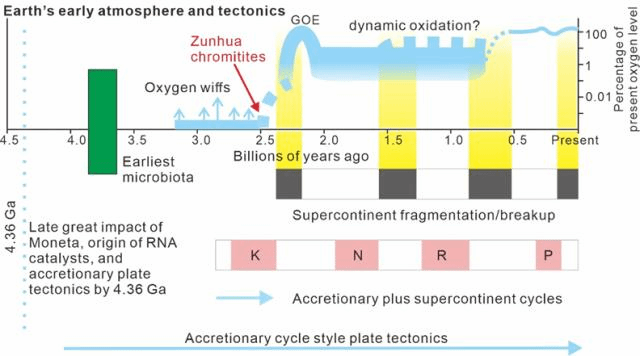Deep Archean subduction and crust-mantle cycling of life-sustaining C-H-O-N-S-P elements documented from North China Craton
A team of researchers from China University of Geosciences, Wuhan, has, for the first time, documented preserved relicts of Archean (> 2.5 billion years ago) subduction of crustal rock components to the deep mantle, near the mantle transition zone at 410 km, and their return to the surface in an Archean orogenic (mountain) belt formed by an Archean plate tectonic collision event.
The research was published in the internationally-recognized top Earth Science journal “Earth-Science Reviews,” by an international team of researchers led by Professors Tim Kusky and Lu Wang, along with their students from CUG and collaborators from Germany and Canada.
The team has documented multiple types of crustal- and mantle-derived mineral inclusions inside a unique rock type called podiform chromitite, known only from oceanic crust and its remnants in ancient mountain belts.
Mineral inclusions include TiO2 (II), which is an ultra-high-pressure (UHP) phase of the common mineral rutile, stable only above 7.5 GPa, or about 270 km. Other inclusions include carbonates, hydrous and nominally anhydrous silicates, oxides, base metals, platinum group minerals, a previously unidentified OsIrS phase, and pure carbon as graphite polymers, which were derived from both crustal and mantle sources.
The documentation of the crustal and UHP mineral inclusions is even more significant, as the team discovered and documented that the host chromite crystals are locally preserved in their ultra-high-pressure pseudomorph, chenmingite, that is stable only above 14 GPa (~410 km).
This represents the first and so-far only known example of this UHP phase of chromite known from Earth, with the other extremely rare examples recovered from meteorites or synthesized experimentally.
The significance of the work reported by the CUG team is that they have shown that traces of the major elements Carbon – Hydrogen – Oxygen – Nitrogen – Sulfur - Phosphorous (CHONSP) needed to sustain a habitable planet were present on the surface of the early Earth, recycled to the deep mantle by plate-tectonic subduction, and returned to the surface through interactions of the crust and mantle.

Schematic diagram show relationships between accretionary and Wilson (Supercontinent) cycles, atmospheric oxygen, the late great impact of planetsimal Moneta, and early hints of life including earliest known microbiota and the origin of RNA catalysts. The deep subduction documented by the Zunhua podiform chromitites occurred when the atmospheric oxygen began its dramatic rise at the Archean/Proterozoic boundary, immediately preceding the Great Oxidation Event (GOE). Abbreviations: GOE-Great Oxidation Event; K-Kenorland; N-Nuna; R-Rodinia; P-Pangea.
These findings show that plate tectonics and subduction have regulated crust-mantle interactions and the life-sustaining deep CHONSP cycles on Earth at least since the late Archean, consistent with numerical models showing how C-O-H cycling related to subduction led to a rapid oxygenation of the mantle in the late Archean, near the onset of the planet’s Great Oxidation Event, coincident with the first development of crown-group eukaryotic cyanobacteria.
Citation
Kusky, T.*, Huang, Y., Wang, L.*, Robinson, P., Wirth, R., Polat, A., Hu, Wei, 2022, Vestiges of early Earth’s deep subduction and CHONSP cycle recorded in Archean ophiolitic podiform chromitites, Earth Science Reviews, https://doi.org/10.1016/j.earscirev.2022.103968, published on-line Feb. 18, 2022.
Use “Share Link” for free download
https://authors.elsevier.com/a/1egON2weQpI%7EE
华北克拉通记录太古宙深俯冲和维持生命元素(C-H-O-N-S-P)的壳-幔循环
近日,我校全球大地构造中心主任蒂姆·柯斯基教授带领的课题组首次报道了保存完好的、俯冲接近410公里深度的地幔过渡带、并经由板块构造碰撞事件折返回地表的太古宙(> 25亿年前)地壳岩石残余物。该研究成果由蒂姆·柯斯基教授和王璐研究员引领的研究团队、与来自德国和加拿大的合作者共同发表在国际顶级地球科学综述期刊《地球科学论评》上。该团队在一种被命名为豆荚状铬铁矿岩的独特岩石类型中发现了多种壳源和幔源的矿物包体,而该种岩石类型目前仅在洋壳及古老造山带中保存的洋壳残片中有过报道。矿物包体中有 TiO2 (II),代表着常见矿物金红石的超高压相,仅在 7.5 GPa以上(或大约270km的地下深处)稳定存在。其他包裹体包括壳源和幔源的碳酸盐、含水和名义无水硅酸盐、氧化物、贱金属、铂族矿物、以及之前未识别的 OsIrS 相和纯碳石墨聚合物。
该团队还发现并报道了在寄主铬铁矿晶体的局部保存的超高压假相陈鸣矿,该晶体仅在 14 GPa(约 410 公里深度)以上稳定 ,这是关于壳源物质和超高压矿物包裹体一项更重要的记录。这是地球上已知的第一个也是迄今为止唯一已知的从造山带中发现超高压相铬铁矿的例子,而其他极其罕见的例子是从陨石中获得或通过实验合成。

示意图显示增生和威尔逊(超大陆)循环、大气中的氧气、Moneta小行星后期强烈撞击以及早期生命迹象(包括最早的已知微生物群和RNA催化剂起源)之间的关系。遵化豆荚状铬铁矿记录的深俯冲发生在大气中氧气含量开始急剧上升的太古宙/元古宙边界,和紧接着发生的大氧化事件(GOE)之前。缩写词:GOE-大氧化事件,K-Kenorland超大陆; N-Nuna超大陆; R-Rodinia超大陆; P-Pangea超大陆。
这项成果的意义在于,研究揭示了早期地球表面存在维持宜居行星所需主量元素碳-氢-氧-氮-硫-磷(CHONSP)的足迹,它们通过板块构造俯冲和再循环到达深部地幔,并通过壳-幔相互作用返回地表。这表明,至少自太古宙晚期以来,板块构造和俯冲已开始调节壳-幔相互作用和地球上维持生命的CHONSP深部循环,这与太古宙晚期俯冲相关的 C-O-H 循环导致地幔快速氧化的数值模拟结果一致,并与太古宙晚期地球大氧化事件启动和冠群真核蓝藻的首次出现相耦合。
文章信息:
Kusky, T.*, Huang, Y., Wang, L.*, Robinson, P., Wirth, R., Polat, A., Hu, Wei, 2022, Vestiges of early Earth’s deep subduction and CHONSP cycle recorded in Archean ophiolitic podiform chromitites, Earth Science Reviews, https://doi.org/10.1016/j.earscirev.2022.103968, published on-line Feb. 18, 2022.
使用“共享链接”免费下载
https://authors.elsevier.com/a/1egON2weQpI%7EE